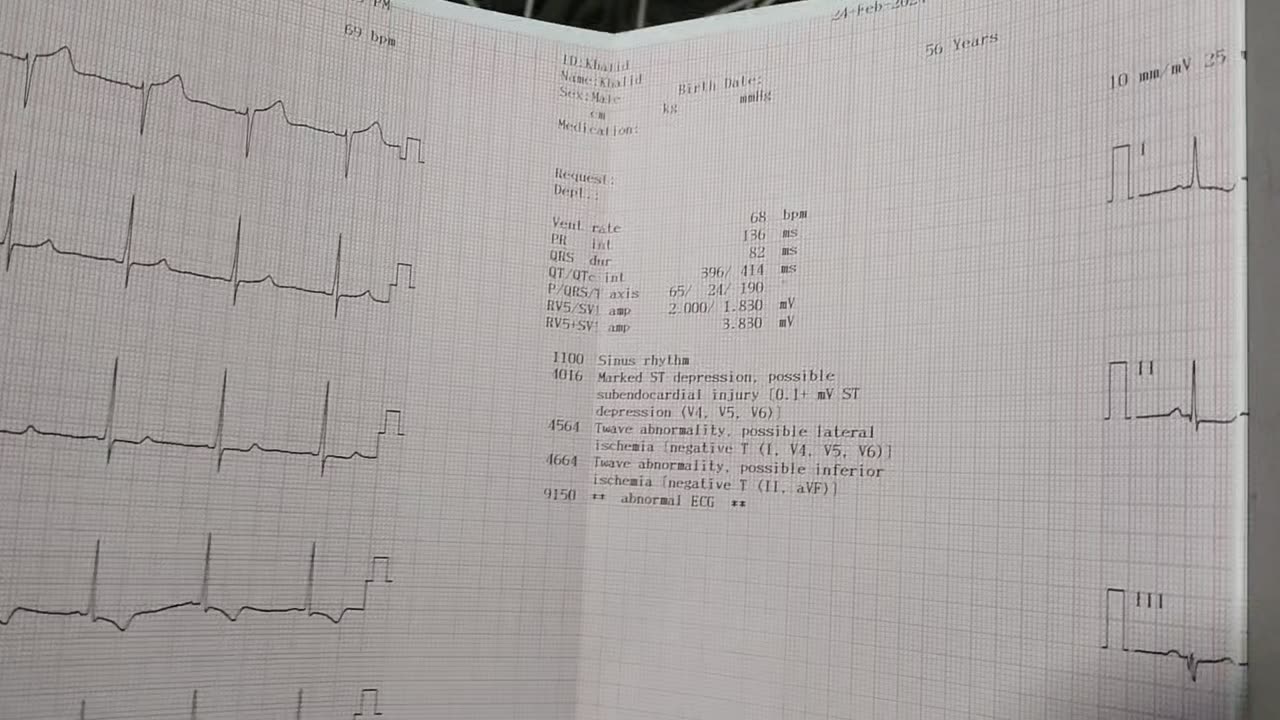Premium Only Content

ECG (Electro Cardio graph /Electro cardio gram) #ECG #cardio #medical #health #MI #arreset
ECG
Electro Cardio graph
Electro cardio gram
Sure, here are 50 points for an "ECG video":
1. Introduction explaining what an ECG (Electrocardiogram) is.
2. Overview of the anatomy of the heart and its electrical conduction system.
3. Explanation of the different leads used in an ECG and their placement on the body.
4. Demonstration of how electrodes are attached to the patient for a standard ECG.
5. Step-by-step guide on how to properly set up an ECG machine.
6. Explanation of the different waves and intervals present in a normal ECG tracing (P wave, QRS complex, T wave, PR interval, QT interval).
7. Identification of common abnormalities seen in an ECG (e.g., atrial fibrillation, ventricular tachycardia, heart block).
8. Discussion on the significance of ECG findings in diagnosing various cardiac conditions.
9. Comparison of normal vs. abnormal ECG tracings.
10. Interactive quiz sections to test viewer understanding of ECG interpretation.
11. Overview of the importance of ECG monitoring in various clinical settings (e.g., emergency room, intensive care unit, cardiac rehabilitation).
12. Demonstration of how to troubleshoot common technical issues with ECG machines.
13. Explanation of how to calculate heart rate based on ECG tracing.
14. Discussion on the limitations of ECG interpretation and the need for complementary diagnostic tests.
15. Interview with a cardiologist or cardiac nurse discussing their experiences with interpreting ECGs.
16. Real-life case studies showing ECG tracings of patients with different cardiac conditions.
17. Guidance on how to document ECG findings accurately in medical records.
18. Overview of the history and evolution of ECG technology.
19. Animation illustrating the electrical activity of the heart during different phases of the cardiac cycle.
20. Tips for improving ECG interpretation skills.
21. Explanation of how exercise stress tests and Holter monitoring complement ECG assessment.
22. Discussion on the role of ECG in guiding treatment decisions for cardiac patients.
23. Explanation of ECG changes associated with electrolyte imbalances.
24. Demonstration of ECG artifacts and how to differentiate them from true cardiac abnormalities.
25. Overview of specialized ECG techniques such as signal-averaged ECG and vectorcardiography.
26. Explanation of the significance of ECG findings in specific patient populations (e.g., athletes, elderly individuals).
27. Tips for obtaining high-quality ECG tracings in challenging situations (e.g., patients with excessive body hair, edema).
28. Overview of the different formats used for ECG reports (e.g., paper printouts, digital formats).
29. Discussion on the role of ECG in preoperative evaluation and risk stratification.
30. Explanation of the J-point and its significance in ECG interpretation.
31. Demonstration of ECG artifacts caused by patient movement and ways to minimize their impact.
32. Comparison of ECG findings in acute vs. chronic cardiac conditions.
33. Overview of advanced ECG techniques used in research settings.
34. Discussion on the ethical considerations involved in obtaining and interpreting ECGs.
35. Explanation of the criteria for diagnosing myocardial infarction on an ECG.
36. Demonstration of ECG monitoring during cardiac procedures (e.g., cardiac catheterization, electrophysiology studies).
37. Overview of the role of ECG in evaluating drug-induced cardiac effects.
38. Explanation of ECG changes associated with various cardiac medications.
39. Demonstration of ECG telemetry systems used for remote monitoring of cardiac patients.
40. Overview of the potential risks and complications associated with prolonged ECG monitoring.
41. Discussion on emerging trends and technologies in ECG monitoring (e.g., wearable ECG devices, artificial intelligence).
42. Explanation of the relationship between ECG findings and prognosis in cardiac patients.
43. Demonstration of ECG interpretation software and its applications in clinical practice.
44. Overview of the ECG findings in congenital heart diseases.
45. Discussion on the role of ECG in diagnosing and managing arrhythmias.
46. Explanation of the effects of autonomic nervous system activity on ECG parameters.
47. Demonstration of ECG-guided procedures such as cardioversion and defibrillation.
48. Overview of the educational requirements for healthcare professionals involved in ECG interpretation.
49. Discussion on the importance of interdisciplinary collaboration in cardiac care, including ECG interpretation.
50. Conclusion summarizing key takeaways and encouraging further learning and practice in ECG interpretation.
#ecg #cardiology #cardiologist #cardiovascular #cardiac #echocardiography #cardiologia #echocardiogram #ekg #heart #cardio #doctor #healthcare #cardiography #medical #bsecho #cardiacphysiology #cardiacphysiologist #mybse #echocardiographer #medicalscanning #britishsocietyofechocardiography #ukmedicine #medicine #bsebest #cardiologyjobs #echojobs #health #hcs #healthcarescientists
-
 LIVE
LIVE
Redacted News
1 hour agoBREAKING! It's starting! DOJ Strike Force Going After Obama / Hillary Criminal Cabal | Redacted
20,651 watching -
 LIVE
LIVE
Michael Franzese
58 minutes agoThis Is the Most Important Thing I’ll Ever Say
433 watching -
 LIVE
LIVE
Barry Cunningham
2 hours agoPRESIDENT TRUMP TOURS JEROME POWELL SCENE OF THE CRIME AT THE FEDERAL RESERVE
2,956 watching -
 UPCOMING
UPCOMING
Sarah Westall
1 hour agoBlackmail, Power & Corruption: The Currency of the Empire - Epstein & more w/ Joachim Hagopian
252 -

The White House
1 hour agoPresident Trump Visits the Federal Reserve
3.24K7 -
 36:14
36:14
Kimberly Guilfoyle
2 hours agoRussia Hoax Reality Check, Live! | Ep240
4.57K3 -
 11:02
11:02
Preston Stewart
6 hours agoThailand–Cambodia Clash Erupts
372 -
 LIVE
LIVE
LFA TV
19 hours agoLFA TV ALL DAY STREAM - THURSDAY 7/24/25
1,614 watching -
 1:07:35
1:07:35
vivafrei
3 hours agoWall Street Journal DOUBLING DOWN on Epstein! Lawyer in Canada DEBANKED! AND MORE!
83.9K20 -
 4:42:20
4:42:20
Donut Operator
5 hours agoI'M BACK/ CRIME/ GAMEBOY CAMERA CHAD
88.6K4